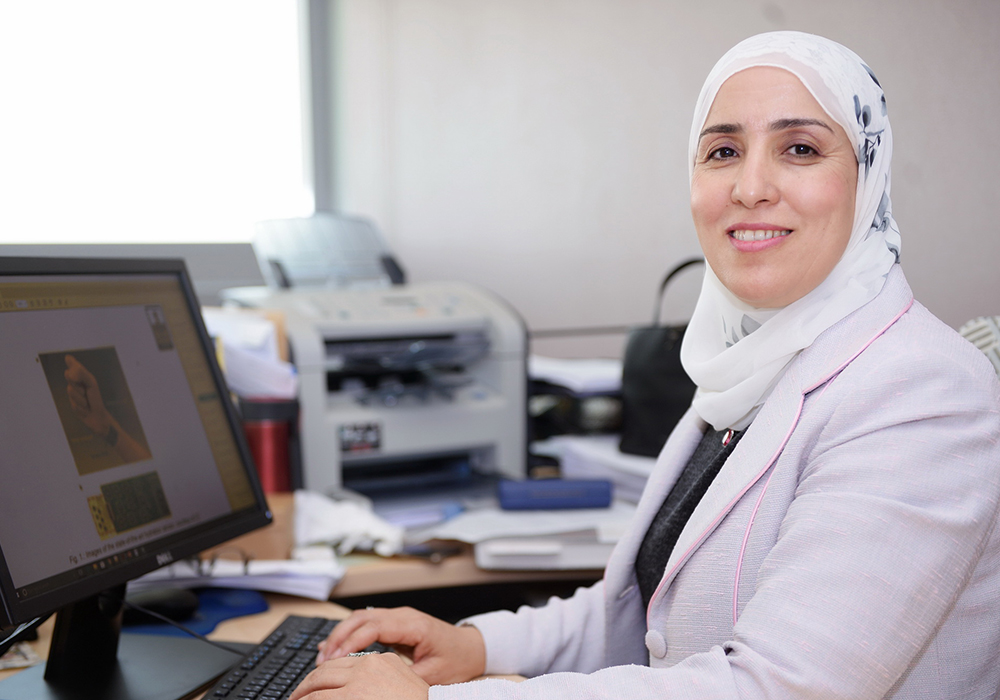Wearable device to track hydration in development by researcher at UAEU
Mon, 6 June 2022

A new wearable device to monitor the hydration and dehydration levels of the skin
is being developed by researchers at the United Arab Emirates University (UAEU).
Using sensing, the creation of realistic tissue phantoms, and modeling and signal
processing, the non-invasive device can be used to track a person’s physical health
through the condition of the skin tissue. “We have good experience in working with
artificial skin and electromagnetic sensory networks inside and on the human body,”
said Dr Najah AbuAli, Associate Professor of Network Engineering at the College of
Information Technology. “The sensory we use are optical – it’s a new research that
uses LED and optical sensors, so we send light in the body, with different wavelengths,
and we analyse the reflected rays. The refraction factor will depend on the water
content of the skin layers.”
She spoke of skin turgor, which is the skin elasticity, and the ability of the
skin to change shape and return to normal. It can be a sign of both fluid loss, known
as dehydration, or fluid gain, also known as edema, and can become a serious condition
particularly for children and the elderly.
Healthy skin includes the right balance of water and sebum. A person needs to maintain
an optimum hydration level for the proper functioning of the body.
The device can also be used during minimal physical activity when people lose substantial
amounts of water. This is compounded particularly for children who have prolonged
vomiting or diarrhea. “It involves continuous monitoring and is similar to wearing
a smart watch and getting your constant heartbeat,” Dr AbuAli said. “Our plan is to
include these sensors in a wristband or commercial watch, and completely monitor the
hydration level of the body. This will help us discover diseases at early stages,
or in sports, or with children if they have diarrhea and vomiting – we can monitor
dehydration on the spot with the information provided in real-time.
Beyond dehydration and edema, many systemic diseases like cardiovascular disease,
diabetes, and cancer, can sometimes be associated with various skin disorders.
Variations of the proposed non-invasive optical wearable technology could be used
to provide additional insight into a user’s health and enable early intervention when
needed. One example has shown that patients with diabetes mellitus tend to show a
reduced hydration state of the stratum corneum (SC), together with decreased sebaceous
gland activity, without any impairment of the SC barrier function.
To address this need for a quantifiable method of measuring hydration, the team will
focus on the design and development of an optical wearable system for monitoring the
hydration levels in the different layers of the skin. This has the potential to directly
impact the measurement of edema and dehydration as well as provide information about
skin hydration that could be correlated to other diseases, including diabetes and
cardiovascular diseases.
The project outcome is a prototype based on optical technologies for measuring water
levels with a database to correlate those levels with hydration measurements.
As part of the research, a multidisciplinary team of expert investigators was gathered,
with backgrounds in electrical engineering, medicine, biomedical engineering, bio-sensing,
optics, computer science, modelling, and signal processing. The experts are from Queen
Mary University, in London, Glasgow University, and the United Arab Emirates University.
The two primary objectives for the project include developing a wearable optical-based
device for monitoring tissue hydration, and developing realistic in-vitro artificial
and tissue-based skin phantoms to test the hardware and software as a function of
water content by skin layer.
Dr AbuAli expects the project to be delivered by January 2020. “We already started
doing our experimentation using artificial skin,” she said. “It’s important because
there’s a well-known fact that cardiovascular disease, diabetes and cancer can be
detected from skin dehydration at a very early stage.”
Athletes can also benefit as they do not always monitor their hydration levels during
sports activities, while children, particularly infants, do not complain in such circumstances.
Data can directly be sent to the parents’ mobile phones to inform them about the dehydration
levels.
The motivation behind the project is driven by the current methods that exist, which
are very invasive. To measure water content in the body, physicians inject people
with a radioactive substance and use x-rays to collect data, before analysing the
intensity of the images to come up with an estimated value of the water content.
Another technique is body impedance, which measures the electrical resistivity of
the human body, and is also considered very rough and inaccurate.
Do you find this content helpful?
عفوا
لايوجد محتوى عربي لهذه الصفحة
عفوا
يوجد مشكلة في الصفحة التي تحاول الوصول إليها

